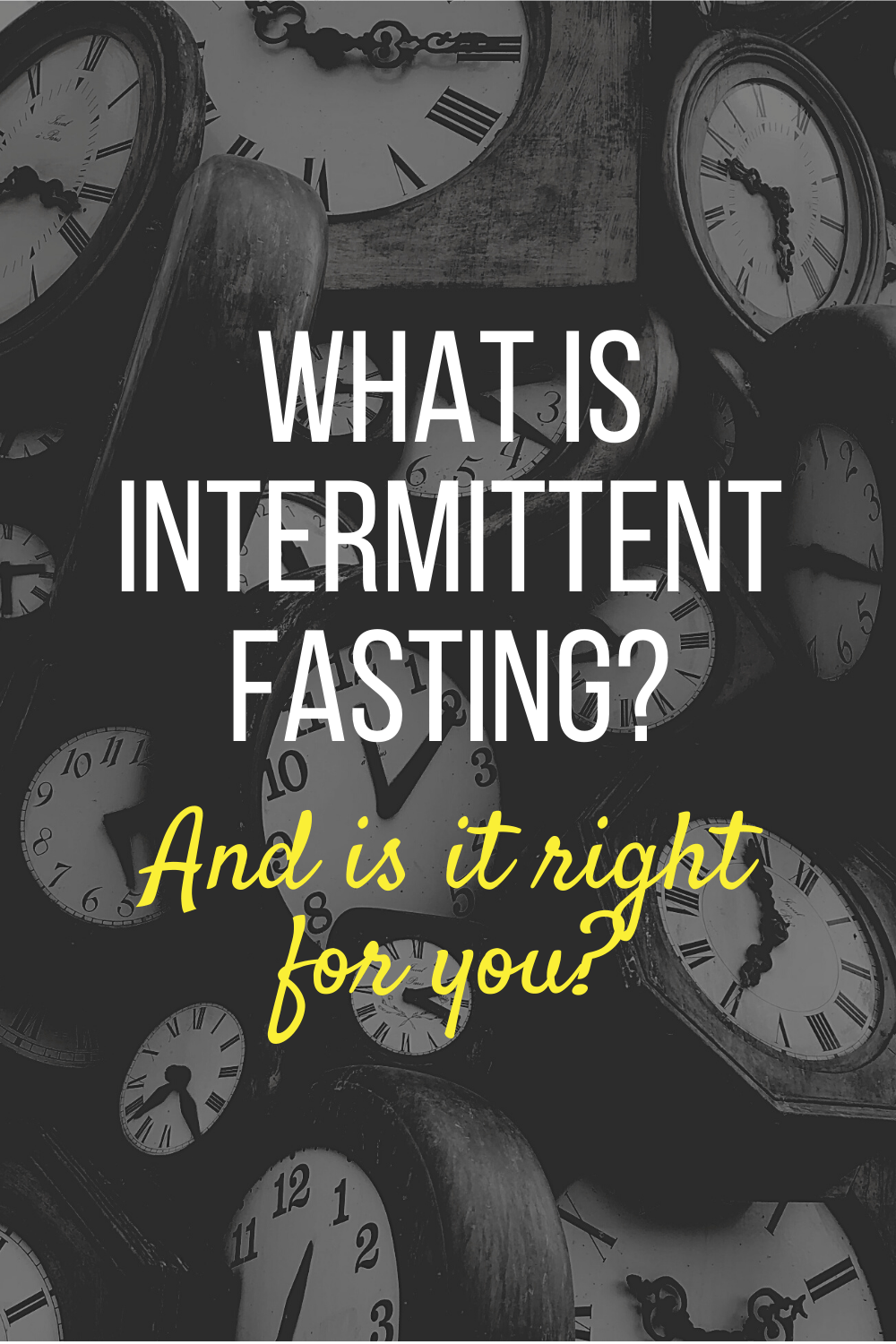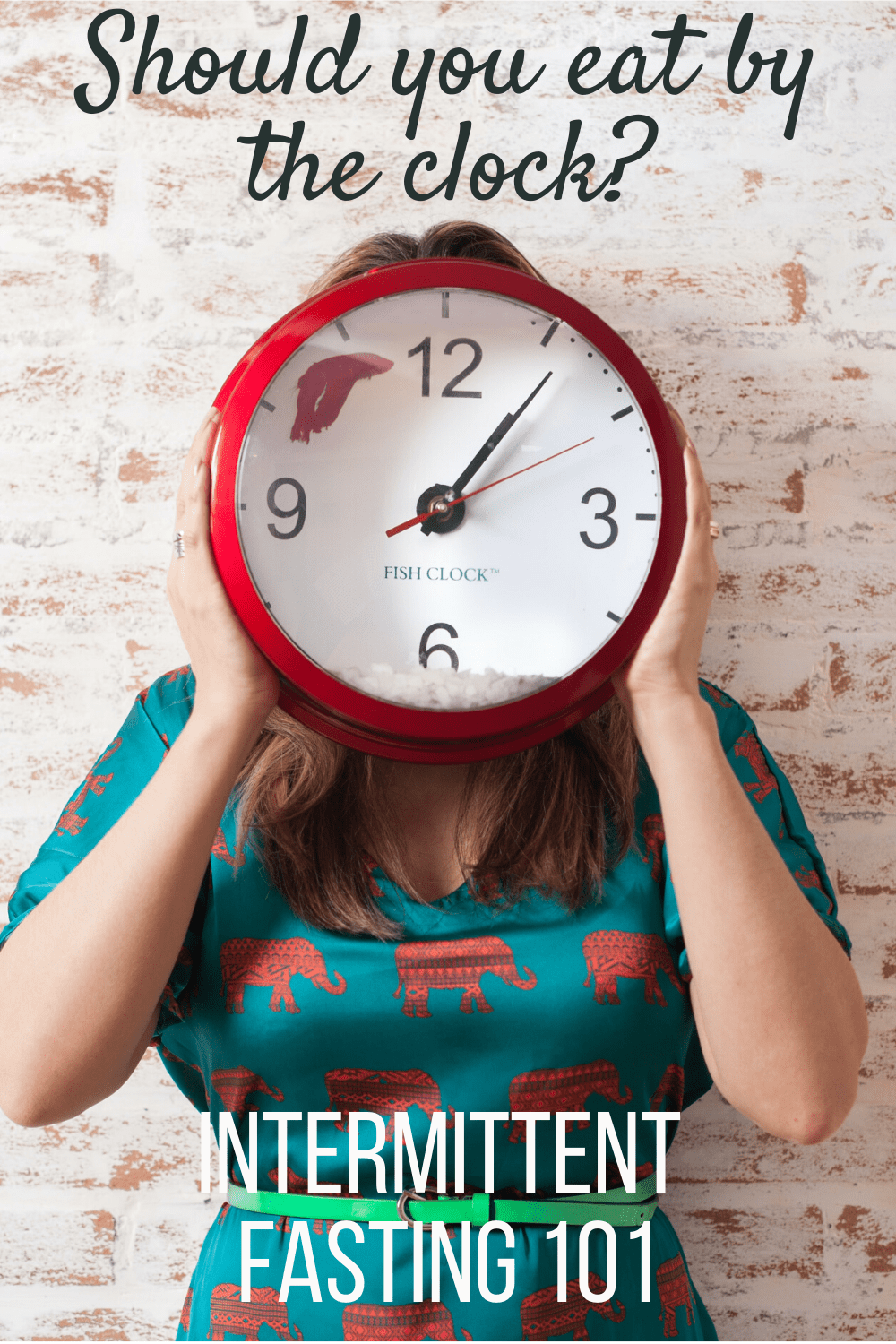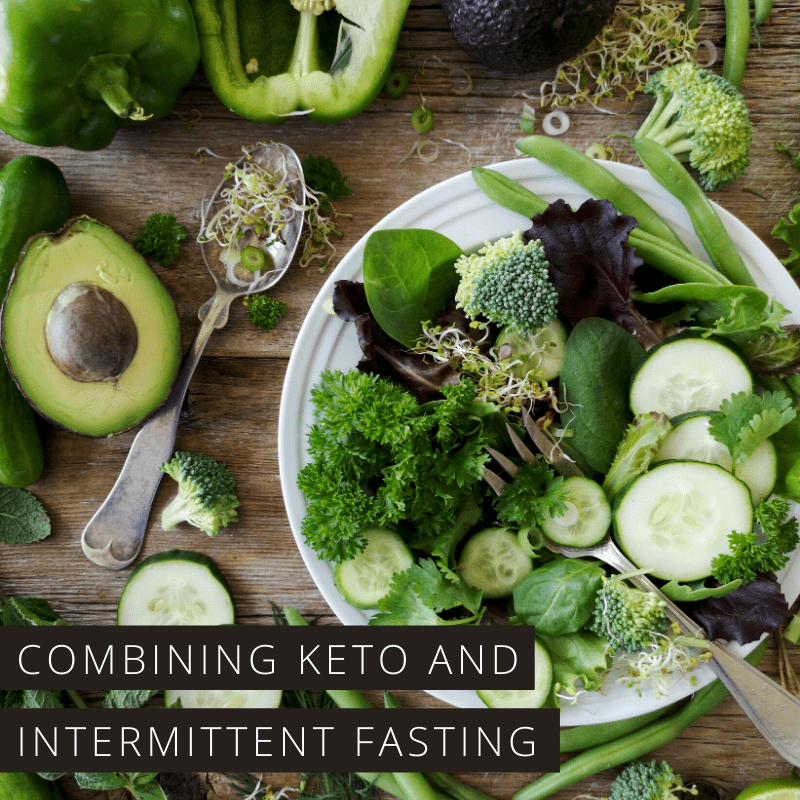This post may contain affiliate links.
Find out whether Intermittent Fasting is right for you or whether you fall into the group of women who should avoid it.

Getting healthy, eating right, and maintaining a healthy weight are all pretty common goals for women. And it seems that every day someone is telling us about a new way for us to achieve these goals.
The buzzword right now is “intermittent fasting”.
We had no idea whether this was something we should be trying, or just another fad, so we set about finding out!
So keep reading to find out what intermittent fasting actually is, how it works, and most importantly what you need to know before you think about trying it, because as with most things what is good for one person isn’t good for another.
Always Talk to Your Doctor First
As always, when making a lifestyle or health change, talk to your doctor first and again if you experience any issues after making the change.
If you experience ANY problems with intermittent fasting, your mental or physical health, or your menstrual cycle, let a doctor know.
What is intermittent fasting?

To put it quite simply intermittent fasting is a schedule of eating.
You stick to a certain number of hours for eating, then a certain number of hours for “Fasting” – where you don’t eat anything.
It is not a diet with rules about you can or can’t eat, but instead focuses on when to eat.
By limiting when and how long you eat each day, you are able to reduce insulin levels, which can help everything from giving you energy and burning fat, to reducing gastric distress and inflammation.
We’ll look more closely at the different protocols of intermittent fasting in a minute, but here are some of the most common ones:
16:8 – You fast for 16 hours, with an 8-hour eating window.
20:4 – You fast for 20 hours, with a 4-hour eating window.
OMAD – You eat once a day, usually within about an hour, and fast 23 hours.
What Do You Eat While Intermittent Fasting?

A very common question about intermittent fasting is what exactly you are supposed to eat.
The answer to that question is, whatever you want.
Well, obviously if you’re trying to be healthy you don’t want to eat junk food.
But the point is intermittent fasting is not about WHAT you eat, but rather WHEN you eat.
What you decide to eat, whether you are eating healthier, counting calories, or following a specific diet is completely up to you.
With that being said, here are some important things to know about what you eat during your feeding windows.
Make sure you get enough calories. No matter what you decide to eat, make sure you are getting adequate calories during your eating window. You might want to track your calories in the beginning until you get used to eating the proper amount, but you don’t necessarily have to do this forever.
Focus on your macronutrients. Your protein, carbs, fiber, and fat are all important to get when you are intermittent fasting. Protein and fat are going to satiate you and help you get through the fasting period, while fiber helps keep you regular, and carbs are going to give you energy.
Go for a healthy balance. It is ok to have treats and yummy things with your meals, but you should also make sur you are getting enough vitamins and minerals in each meal. Don’t forget about vitamins, iron, folic acid, and other important nutrients.
What Breaks a Fast?
Another thing to remember is that the only things guaranteed to not break a fast are plain water, tea without fruit or sweeteners, and black coffee.
Many people will talk about various drinks and foods that they claim don’t break their fast, or at least not enough to make a difference.
This might include:
- Water or drinks with artificial sweeteners
- Anything under 50 calories
- Sticking under a specific amount of protein
- Bulletproof coffee
It is really up to you and what you see the best results with.
For example if you have been having sparkling water during your fasted period, and aren’t noticing many benefits, then the artificial sweeteners in that water may be breaking your fast without you realizing it.
This is why it is important to keep track of what you are eating and the effects you are experiencing so you can look for connections. But we’ll get to that in a minute.
What are the benefits of intermittent fasting?

You’re probably thinking “is intermittent fasting a good way to lose weight”?
And the short answer is yes – you can definitely lose weight with intermittent fasting, but for now, consider that a good side effect.
We really want to encourage you to look at all the health benefits of fasting, since there are many ways it can improve your overall health and wellness.
It Could Reduce Your Inflammation Levels
The first health benefit you might notice when you start intermittent fasting is an improvement in your levels of inflammation.
Many people who practice this form of fasting have found that their bloating and inflammation tends to go down, thanks to the reduced eating window, lower insulin levels, and less stress on your digestive system.
Whether you have arthritis or tend to get very bloated with a lot of water retention, this can be an amazing health benefit for you.
It Might Lower Insulin Resistance
When you have insulin resistance, your body doesn’t know how to regulate insulin in your body properly, which often causes it to increase your blood sugar.
In addition to a higher risk of diabetes, this can also lead to weight gain in many people.
With intermittent fasting, you are regulating your insulin levels much more effectively, therefore it can be a great fight against insulin resistance if you believe this is something you are struggling with.
You May Have Lower Risk of Heart Disease and Diabetes
When it comes to heart disease and diabetes, it is usually about making healthier lifestyle choices in order to reduce the risk. Thankfully, intermittent fasting can be added to this list.
With the better balance of insulin and reduction of insulin resistance, and the overall healthier eating habits people tend to have when they are fasting, it is great news if heart disease, stroke, or diabetes runs in your family.
A study has also shown that intermittent fasting could help in preventing type 2 diabetes.
More Health Benefits
Women and men have also reported many other health benefits thanks to intermittent fasting including:
- Faster fat burning and weight loss
- Higher natural energy levels
- Reduced hunger and cravings
- Faster recovery from surgery
- Improved memory and brain function
- Less brain fog
- Reduced belly fat
Why is it so Effective for Weight Loss

Now for what you really want to know about – weight loss!
Yes, intermittent fasting is an amazing way to burn fat and lose weight.
But why is it so effective?
Well it all comes down to your insulin levels.
Someone who starts eating early on in the day right through to the evening, with lots of snacking between meals, is probably continuously raising their insulin levels throughout the day.
This causes insulin spikes, which is going to stop fat burning.
Plus, too much insulin can actually make you gain weight as this is the hormone that helps to regulate how glucose is absorbed by the cells in your body.
You Can Get Into Ketosis and Burn Fat
Another way that IF can help with fat burning is by getting into the state of ketosis.
People often believe that you have to do the keto diet to achieve ketosis, but that isn’t necessarily the case.
You are in a ketosis state during longer stretches of fasting until you start eating again, so this also helps you to burn more fat.
Ketosis is a type of metabolic process where your body is going to convert fat into energy, which increases how much fat you burn.
Intermittent fasting can get you into shorter periods of ketosis, even without actually doing the keto diet.
Though of course it is more effective when you combine intermittent fasting and keto.
It Helps to Curb Your Appetite
It is not uncommon to start eating less when you follow the IF schedule, not just because of the limited eating window, but because your appetite changes.
This is thanks to a number of things, from your lower insulin spikes throughout the day, to fewer meals being eaten.
When you snack every couple hours, you probably have more of an appetite. But if you can reduce your meals to 2-3 a day only with no snacks in between, you will be amazed by how much more level and balanced your appetite becomes.
You Eat Less Calories Overall
You will also probably eat less calories, even if you don’t intend to, especially when you have eating windows between 1 and 4 hours. There is only so much time to eat, so your meals tend to be a little smaller overall and your calories go down.
However, you do want to make sure you are eating enough, so if you have low energy or feel starving all the time, then you might want to track your calories to see how much you have been eating each day.
Are There Any Downsides to Intermittent Fasting?

Intermittent fasting can be very effective for women, but it is not a magic pill.
There are still some drawbacks to be aware of before you make the leap.
Social Eating Might Change
One of the most common downsides to intermittent fasting is that you can’t just go out for drinks, coffee, or to eat at any time.
Your social obligations might change where you are saying no to friends or certain types of activities depending on when you typically fast.
However, if you find this is negatively impacting your life, consider whether or not you need to fast every day.
There is still a lot of room for flexibility when you are fasting.
You can choose to not fast on days when you go out with friends, or just adjust your fasting window on those days.
Feasting During Eating Windows
This is something people brand new to intermittent fasting might do, since you are going longer periods of time without eating.
When your eating window arrives, you can sometimes be so ravenous, that you over-indulge and eat much more than your body wants or needs.
The best way to prevent this from happening is to adjust your eating and fasting windows slowly.
So instead of going straight to 16 or 20 hour fasts, try to start eating an hour later than normal in the morning, or stop eating an hour earlier than you typically would at night.
Keep moving the windows further and further until you reach the fasting window you want to stick with for a while.
Digestive Issues
While intermittent fasting can be great for reducing bloating and gas, you might experience the opposite effect.
This can happen for a few different reasons.
First of all, if you have a condition like gastritis, it is better for you to eat smaller meals throughout the day.
Having 1 or 2 big meals might disrupt your condition.
In this case, either split up your meals in a larger eating window, or talk to your doctor about your options.
Another cause for discomfort is probably that you are eating too much, too quickly, during your eating window.
Start slow, preferably with low glycemic foods first, then you can eat a regular meal.
Having Too Many Rules
Lastly, if you are too rigid with your intermittent fasting, it can be more disastrous for you.
People who have a history of disordered eating habits or obsessive thoughts about food struggle with being told they can only eat during certain times.
If this is you, intermittent fasting may not be the best option for you.
Intermittent Fasting Protocols for Women

There are many different ways to do intermittent fasting, with a variety of protocols.
The intermittent fasting protocol is the number of hours you intend to fast and eat.
The fasting hours are when you are not eating and only consuming water, coffee or tea, then you have a shorter eating window when you eat what you want, according to your lifestyle and any diet you might be on.
There are a wide range of protocols you can try, even going as low as fasting for 12 hours and eating for 12 hours, doing the standard 16-hour fast, or even up to 23 hours or longer.
To get you started, here are some of the most common intermittent fasting protocols that people, especially women, like to do.
Standard Protocol – 16:8
The most common and popular intermittent fasting protocol is the 16:8.
This is what most people start with, and many people just stay with this protocol since it fits in well with their lifestyle.
When you hear people talking about skipping either breakfast or dinner, or eating their first meal at noon – they are usually referring to the 16-hour fast, 8-hour eating window.
How to Do the 16:8 Protocol
The 16:8 intermittent fasting protocol is simple. You will fast for 16 hours, then have an 8-hour eating window.
There are no other rules of this fast.
Just make sure you have a good way to track the fasting and eating windows, and that it fits good with your schedule.
When Do You Fast?
The time you choose for the 16 hours is completely up to you.
Many people talk about not eating until noon or skipping breakfast, so they tend to eat lunch and dinner, sometimes a snack in between or a snack after dinner.
But if you aren’t as hungry in the evening, you might prefer eating breakfast or lunch, or fitting in 3 smaller meals within the 8-hour eating window.
The great thing about intermittent fasting is that there is a lot of flexibility in when you move your fasting and eating times, according to your schedule.
Benefits
There are many benefits to the classic 16:8 protocol.
First of all, with an 8-hour eating window, there is a bit more flexibility.
You can space out your meals so you aren’t trying to eat a day’s worth of calories in only a couple hours.
It is also better for having a social life, since you might have your eating window during happy hour or dinner out with friends.
This is also the longest eating window among the typical protocols, so that can be another benefit.
Recommended for Women
When you read about intermittent fasting for women and the studies being done on how your hormones could be affected, 16:8 is usually ideal and recommended the most for women.
You still have a decent eating window, so it probably won’t have quite as much of an effect on how you feel.
Warrior Diet – 20:4
The next type of intermittent fasting protocol is called 20:4, which is when you fast for 20 hours and have a 4-hour eating window.
There are many people who go between 16:8 and 20:4, and anywhere in between.
Maybe one day you fast for 16 hours, and the next day you fast for 18 hours.
This is a good option for women with varying schedules day by day.
How to do the 20:4 Protocol
As you might expect, the warrior diet involves having a 20-hour fasting window, then eating over the course of 4 hours.
Those 4 hours can include any number of meals or snacks as you want, as long as you don’t eat anything outside of the 4 hours.
Tips for Easing Into the 20-Hour Fast
Since 20 hours is a long time to be fasting, you don’t want to go straight from eating any time you want, to restricting your eating window to just 4 hours a day.
Your body needs time to adjust.
Not just in controlling your hunger for that long, but for your digestive system as well.
You might have split up the same amount of calories between 3 meals and a snack, and now have the same amount of food in just 1-2 big meals.
It’s a lot for your body to adjust to at first.
You definitely want to ease into it by maybe starting with a 12 or 14 hour fast, moving up to the 16:8, then gradually reducing your eating window by an hour at a time.
Eventually, you will reach that 20 hours and it will be much easier to get through.
Does the Time Matter?
Like the other types of fasts, when you choose to move your eating window doesn’t matter as much as the fact that you eat for 4 hours, and fast for 20.
Who Might Want to do 20-Hour Fasts
This is not for everyone, but there are a few types of people who prefer doing 20-hour fasts.
Someone who wants to burn more fat. If your main focus with intermittent fasting is to burn fat and lose weight, then in general, the longer you fast, the more fat you can potentially burn.
Someone who doesn’t get hungry as often. You might be someone who only gets hungry during one or two phases throughout the day. This can make it a little easier for you to do the warrior diet.
Someone who likes big meals. If you struggle with always wanting big meals, the 20:4 is ideal, because you can have 1-2 larger meals and be completely satiated.
One Meal a Day
If you are interested in extending your fast even further, you can do the popular OMAD, or one meal a day.
This is just like it sounds – you eat one big meal a day, typically within a one-hour period.
You are then fasting the other 23 hours of the day.
Keep in mind this is an extended fast, so it is not something you should try on day one of fasting.
Women who decide to do OMAD typically work up to it.
How to Do OMAD
If you are interested in doing OMAD, just like with the 20 hour fast, you need to work up to it slowly.
It is really not recommended that you shock your body into eating just one time a day.
To decide when you want your one meal a day, think about when you tend to be the hungriest during the day, whether that is after your workout, dinner after you get home from work, or in the middle of the day.
How Long is the Meal?
With OMAD, your meal time is about 1 hour.
Some people eat in less time, but by extending it to an hour, you have time to allow your food to digest, and can have another snack or dessert afterward if you need the calories or are still a little hungry.
Things to Understand About OMAD
Before you attempt OMAD, there are a few things to keep in mind:
You still need to hit your calorie and macro goals. Make sure that one meal you eat is enough calories for the entire day, and also contains enough fiber, protein, and carbs to keep you going. You don’t want to lose out on energy or have physical or emotional issues because you aren’t eating enough.
Your meal should be nutrient-dense. Make sure the bulk of what you eat contains enough nutrients for your body for an entire day. This includes all the essential vitamins and minerals, fiber, calcium, iron, and everything else your body needs.
It will need to keep you satiated for another 23 hours. Have plenty of healthy fats in your meal to ensure you stay full until your meal the following day.
Alternate Day Fasting
Lastly, you can go for an extended fast, such as with alternate day fasting (ADF).
This is not easy to do, and is really only a good option for certain people.
Keep in mind that like all forms of fasting, your eating windows (or days in this case) should not be binge days, and follow whatever diet plan or healthy lifestyle plan you have.
There are several studies about the benefits and effectiveness of ADF, including this one on alternate day fasting in obese people and this one on a modified version of alternate day fasting.
How to do Alternate Day Fasting
With alternate day fasting, you are only going to eat every other day.
How much you eat on those eating days depends on your goals, but you shouldn’t be eating small meals.
The fasting days are nothing but water, coffee, and unsweetened tea, though some people do allow up to 500 calories in food on “fasted” days.
Cautions and Things to Keep in Mind
This is not recommended if you have a history of eating disorders or disordered eating.
Alternate day fasting is never a good idea for someone who has a history of anorexia, binge eating, or compulsive overeating.
If you don’t have a healthy relationship with food, please talk to your doctor before you attempt this or other forms of intermittent fasting.
You still want to be careful with how much you consume and what you eat on your eating days.
You want to make sure you get adequate nutrition, calories, and macronutrients on these days.
Choosing the Best Protocol
If you are still not sure which intermittent fasting protocol is going to work best for you, here are a few more tips:
Choose 16:8 if You Like to Eat 2 or More Meals a Day
16:8 is going to be a good starting protocol for all women, so it is still recommended that you start here. There are many reasons to choose this one, but especially if you are someone who wants more smaller meals, instead of less bigger meals.
With an 8-hour eating window, it is much more likely that you can eat 2-3 meals within that time, and feel more comfortable and satisfied.
Consider Alternate Day Fasting if You Have Been Successfully Fasting for a While
While some women have had success just starting off with alternate day fasting, keep in mind you will only be eating every other day.
Our suggestion is to start with 16:8 or even 14:10, then gradually decrease your eating window and increase your fasting window.
If you get to about 1-4 hours a day of eating with the rest fasting, then you might be able to push it further and try ADF.
Go with OMAD if You Want a Big Meal in Less Time
As we mentioned earlier in this guide, one meal a day (OMAD) is ideal if you want to eat a bigger meal, but just one a day.
This is good for people with a busy schedule who tend to “forget to eat” except once a day, or who simply prefer those bigger, more filling meals.
20:4 is a Good Transition Between 16:8 and OMAD
This is something a lot of women work up to, but rarely start at.
You will notice that the longer you do intermittent fasting, the easier it is to extend that fasting window and eat in fewer hours during the day.
Is Intermittent Fasting Different for Women?

One concern people have when it comes to intermittent fasting is whether it is different for women and men.
There is no doubt that intermittent fasting has dozens of health benefits for both men and women alike.
However, due to the differences in hormones, women do need to be a little more cautious when it comes to fasting, especially if they are in their childbearing years.
While the science is still being looked at as far as women and intermittent fasting goes, here are some things to know about fasting for women.
Intermittent Fasting and Your Hormone Levels
One of the main reasons women need to be a little more careful with intermittent fasting is because of how it could potentially affect your hormone levels.
Keep in mind that it isn’t a problem for all women, and you definitely want to talk to your doctor about it first.
Studies are continuing to be performed on the effects of intermittent fasting on women, but here are a few things we know so far.
Your Blood Sugar May Be Affected
There was one study that showed some women noticed that after only three weeks of intermittent fasting, they had poor blood sugar control, but the same was not true for the men in the same study.
Irregular blood sugar levels could potentially increase your risk for type 2 diabetes, which is probably the opposite of what you want with your fasting journey.
This of course is limited based on the study participants, but it is definitely something to keep in mind if you want to try out intermittent fasting for yourself.
You Might Notice Shifts in Your Menstrual Cycle
One of the more common issues with women who do intermittent fasting is that it can cause disruptions within your menstrual cycle.
You might notice that you ovulate late or not at all, your cycle is longer or shorter than usual, or you even miss a period or two.
This is not only from the fasting itself, but likely from the calorie restriction at the same time.
Most people who do fasting are limiting their calories at the same time, either naturally through fasting or because you are trying to lose weight.
This can be really hard on a woman’ body especially and disrupt her hormone levels.
Definitely keep track of your cycle so you know if you should stop or not.
Modified Intermittent Fasting is Recommended
If you are concerned about the effect it could have on your hormone levels or cycle, then it is best to modify intermittent fasting protocols. There are a few ways to do this:
- Increase the fasting window.
- Don’t practice IF every day.
- Take entire weeks off.
Your Menstrual Cycle and Fertility
Speaking of how your hormones can change, if it does affect these levels, you might deal with problems relating to your menstrual cycle and fertility.
Fertility is your ability to conceive a child, so if you are in your childbearing years, it is definitely something to keep in mind.
How does fasting affect your cycle and fertility?
You may stop ovulating. Ovulation is when you release an egg, which can then be implanted by sperm during your fertile window, and may result in a pregnancy. None of this is possible if intermittent fasting affects your ability to ovulate.
Some women have reported that they stopped ovulating entirely, didn’t ovulate every month, or simply had no idea when they would ovulate because their cycles became very irregular from fasting.
Again, this might be from the fasting itself and your body going into protection mode assuming you are not consuming enough, or from actually not eating enough and experiencing amenorrhea (missed periods).
Women Who Shouldn’t Fast
There are certain groups of women who might be told not to fast or at least not to extended fasts. This includes:
Women Who Have Irregular Periods or Menstrual Issues. Unfortunately, intermittent fasting is likely to just make these issues first.
If you still want to try IF, at least talk to your doctor first and let them know. They should give you some direction as far as what you can do to increase tour success without making your menstrual issues more severe.
Women Who Are Trying to Conceive. Because of the possibility that intermittent fasting could affect your hormone levels, it is not ideal if you are actively trying to conceive, especially if combined with known hormonal imbalances or menstrual cycle irregularities.
Women with a History of Disordered Eating. This also goes for men and non-binary people. Nobody should be doing intermittent fasting if you have a history of any type of disordered eating. This includes eating disorders, compulsive eating, obsession over eating or diets, binge eating, and sometimes even emotional eating.
Women Who are Pregnant or Breastfeeding. Doctors suggest not doing fasting if you are pregnant or breastfeeding. You need all the nutrients you can get, and unfortunately fasting does put you at risk for not eating enough during the day.
Women Who are Underweight. If you believe you are underweight, please talk to your doctor before attempting to fast.
Women with High Amounts of Emotional Stress. It may not be the ideal situation if you are going through a lot of emotional stress right now, including stress about your body or your diet. It might make your issues worse, instead of better.
Tips for Doing Intermittent Fasting Safely and Effectively

Once you have decided you want to give intermittent fasting a try, it’s time to make some decisions.
You will need to decide what intermittent fasting protocol to go with – including how long to fast and eat, as well as if you plan to do any type of diet, and more.
Here are some tips and tricks for not only doing intermittent fasting effectively, but safely as well.
Start With Your Current Eating Schedule and Make Small Changes
The easiest and most effective way to do intermittent fasting and see if it works for you is by making small changes.
This is true of just about any lifestyle change you decide to make.
You can’t completely flip your routine upside down and expect it to be easy.
Intermittent fasting is no different. If you currently have a 14-hour eating window because you snack a lot during the day and at night, cutting it down to 8 hours overnight is going to be hard for your body to adjust to.
Instead of such a shock to your system (and hormone levels!), take it slow and steady.
Think about small changes that will get you closer to the eating window you want to be at.
Consider When You Eat Now, and Shorten That Window By One Hour at a Time
This is probably the easiest and less complicated way to start easing into your intermittent fasting protocol.
It not only helps your body adjust at a slower pace without shocking the system, but it helps you see if this is going to work with your lifestyle or not.
Think about what time you typically stop eating at night, whether it Is 7 pm or midnight, and stop eating about an hour earlier than usual.
If you typically have late night snacks at 11 pm, cut yourself off at 10pm instead.
Another way is in the morning before your first meal. If you eat breakfast around 9am, try pushing it to 10 or 11am at first to see how you feel.
Gradually move your window further and further away.
What Time of Day Are You the Most and Least Hungry?
Another way to make small changes as you ease into intermittent fasting is to think about the time of day when you are the most hungry, and the time of day you are the least hungry.
It seems so simple, but is something a lot of people overlook.
Do you eat dinner late because that is when you are hungry, or because it is a habit?
Do you care about breakfast at all?
Do you want to skip breakfast and eat at noon for fasting because most other people do it that way, or are you generally not hungry in the morning?
Don’t forget that your eating window can be at any time during the day, so the most important thing is to think about when you are hungriest, and make sure your eating window is around there.
What Are Your Main Issues With Your Current Eating Schedule?
Lastly, consider your current eating schedule again, and think about why you want to change it.
Why are you trying intermittent fasting, and how is it going to fit in with your schedule?
Maybe you know you aren’t hungry much at night, so skipping dinner is easy. Or you find that you rarely even remember to eat breakfast and lunch, so OMAD works great since all you have to do is eat a big, nutritious dinner every day.
For Women, 16:8 is Ideal
There are a lot of different fasting protocols, and women can try any of them they want.
You will find women who do OMAD or 20:4 just fine, even alternative day fasting.
However, women are recommended to start with a longer eating window to help balance their hormones.
Not all women have to stay here, but it is suggested that you at least start with 16:8, and if it is working good for you and you are comfortable with it, there is no reason to push it and try to fast for as many hours as possible.
Why fix what isn’t broken?
Some Reasons You May Want to Consider Extending Your Fasting Window
However, for some women, 16:8 isn’t the best option.
Here are some signs that you would do even better with a shorter eating window and more fasting time:
- You struggle eating more than 1-2 times a day.
- You only eat during a short period within those 8 hours.
- You accidentally fast more than 16 hours without realizing it.
- You aren’t noticing any health benefits from the 16:8 schedule.
Keeping Track of your Intermittent Fasting Journey

Whenever we make any changes in our life to improve our health or wellness it’s important to keep track of them so we can see what is working and what isn’t.
The easiest way to do this is by starting a journal or using a binder so we have all the information we need in one place.
Here are some things that you should keep track of.
Why You Decided to Try Intermittent Fasting
Start out by writing down why you decided to try IF, and how you are hoping to benefit from this change.
Here are some journal prompts to help you:
Why do you want to try intermittent fasting?
Do you have any past experiences with fasting?
List your pros and cons of intermittent fasting.
What are your short term plans with fasting?
What are your long term plans with fasting?
What is your personal history with dieting?
Do you prefer eating 2 or 3 meals a day?
Do you think you have a good or bad relationship with food?
How are you going to make sure you get enough nutrients in your meals?
What changes do you plan to implement moving forward?
Is there a specific diet you want to try with fasting?
Keep Track of Your Windows

You will need to find an easy way to keep track of your eating and fasting windows, instead of just counting in your head.
This is especially important if you might have varying times each day.
Even if you feel like you have a consistent schedule, unexpected things may come up that push your eating window or fasting window by a little bit, so it gets confusing very quickly.
You can use a printable intermittent fasting tracker like this one from Print My Planner.
Or you can use an app.
There are a lot of apps that track the hours for you, but Zero is one of the most popular.
You are able to choose which fasting protocol you are doing, then push a button on the app when you start your fasting window, then again when you start your eating window.
Don’t Forget to Track How You Feel!
In addition to tracking your fasting and eating windows, track how you feel as well!
This includes both positive and negative changes.
Here are some things you want to track and pay attention to:
Your eating habits. Have your eating habits changed while doing intermittent fasting? For the good or bad? Make sure you are developing good habits, not poor ones. If you aren’t eating enough because of intermittent fasting, it might mean you need to make some improvements.
Your sleeping habits. Has your sleeping changed at all? Keep a log of the hours you are sleeping, whether you are falling asleep earlier or later, and if you have noticed good or bad changes in your sleeping patterns.
Your emotional and mental state. Definitely don’t forget about your emotional and mental health! It is just as important as your physical health when determining if intermittent fasting is the right option for you. Keeping a mood tracker can help you monitor the affect on your emotions.
Your energy levels. Do you feel like you have a good amount of energy? Are you more tired, or do you have natural boosts in your energy?
Your focus and concentration. Write down a log of how your focus has been, and whether or not it has improved or maybe gotten a little worse.
Your hunger and appetite changes. Of course, write about your appetite! Are you hungrier with more cravings, or have you noticed you are satiated for hours and not as hungry during your fasted periods?
Your digestion. Lastly, don’t forget about your digestion. Many women notice improvements in their digestion, but some notice it gets worse. This is also something that can tell you if intermittent fasting is good for you, or maybe if you just need to adjust the protocol you have been doing.
Review Your Progress and Your Feelings About Intermittent Fasting
Here are some more journal prompts to use once you start IF so you can decide whether it is working for you.
What protocol are you doing and why did you choose it?
What have you been eating in your intermittent fasting journey?
How much food have you been eating during your eating window?
How has your snacking changed since starting fasting?
Do you notice any changes in your digestion?
Are your sleep patterns any different?
Have you noticed a change in your energy levels?
What type of exercise have you incorporated?
What benefits are you noticing so far?
Is intermittent fasting something you would recommend to others?
What do you miss the most from when you didn’t fast?
Have you had to deal with any social obligations while fasting?
Do you wish you started your IF journey sooner?
What are some misconceptions you had about fasting?
List some important lessons you have learned so far.
Do you notice more clarity now that you are fasting?
Has your brain fog lifted at all?
How are you getting through the fasted periods?
List 3 things you like about fasting.
List 3 things you donít like about fasting.
How has your schedule changed to accommodate your fasting schedule?
Do you feel intermittent fasting is improving your routine?
List 3 friends you can tell about intermittent fasting and why they might enjoy doing it.
What are 10 healthy foods you would like to eat more of?
If you started your fasting journey over again, what would you do differently?
Have you considered doing OMAD (one meal a day)?
Would you ever want to try alternate day fasting?
List 5 exercises you would like to incorporate into your routine.
What weight loss benefits have you noticed?
What are some ways your mental health has improved?
Are you happy you decided to try intermittent fasting?





